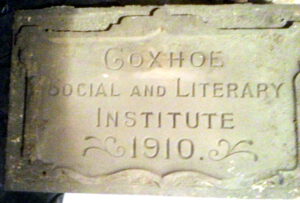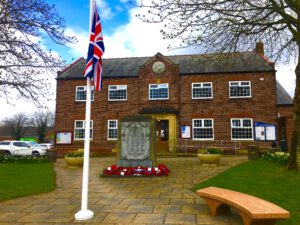Coxhoe Village Hall, as it is now known, began its life in 1910 when four cottages on the front street were converted into Coxhoe Temperance Institute, with two rooms for billiards, and rooms for reading and games. This soon became too small for the growing community and by 1913 plans were being made for a new building.
These were interrupted by WW1 and the great depression afterwards, but by 1932 the community had raised funds for a new building. The site chosen was behind the cottages which were then demolished. Early deeds show it was also named Coxhoe Temperance Institute but shortly afterwards was renamed Coxhoe Social and Literary Institute and Village Hall.
Coxhoe had no colliery welfare scheme, similar to other villages in the district, because the collieries in the village were exhausted towards the end of the 19th century, and the men and boys who worked as miners were employed at a number of the villages. They had to go it alone.
Miss Wood of Coxhoe Hall was president of the working committee and money was raised by whist drives, concerts, bazaars and other popular events.
Prominent members of the community and business people formed a committee and became Trustees. Mr T. A. Saint, manager of the Raisby Limestone Co. Ltd., was chair of the Building Committee.
Plans were developed by architect Mr W. A. Kellett and the building erected by W. Lazenby of Ferryhill.
The first part of the building was opened in 1935 and comprised a large meeting room for women’s meetings, etc. on the ground floor, a reading room divisible into two rooms when required by means of a folding partition, crush hall and cloak room accommodation.
A side entrance and staircase leads to the first floor, where the accommodation comprised a billiard room with two tables, games room, cloakrooms and buffet. The building was designed with a view to the convenient completion of the whole scheme, which included an assembly hall to seat 350 persons, full-sized state, ante-rooms, supper room, kitchen, etc. at a future date. Central heating and electric lights have been installed throughout.
The cost, exclusive of furnishings, was £1,750. Over £1,400 had been raised at the time it was opened. Within a year an appeal for donations and a membership drive enabled the association to clear the overdraft of £700.
Foundation stones were laid on behalf the Steetley Lime and Basic Works, Raisby Limestone Co. Ltd., Walter Scott Ltd., owners of East Hetton Colliery and the Women Workers.
Miss Maud Wood of Coxhoe Hall performed the official opening. Both Miss Wood and her brother John were involved in village life and helped financially.
The dance hall was added in 1938. This could seat 350 persons and includes a full sized stage, anterooms, supper rooms and kitchen. The spring loaded dance floor was recognised as one of the best in the district for many years.
The Village Hall suffered a decline in the 1960s, mainly by the rising cost of administration, income not keeping pace and the passing on of old trustees. New trustees were found, funds raised and the Village Hall was rescued.
For many years the Hall was the base for village social activities and services including Women’s Institute, Over Sixties Club, Youth Club, carnival events, discos, dances, theatre visits and pantomimes, child welfare clinic and library.
There have been fluctuations in performance in the past and yet again the community has mustered to refurbish and update the fabric of the building and increase the range of activities to ensure it is restored as a vibrant and essential hub of the community.




Recent Comments